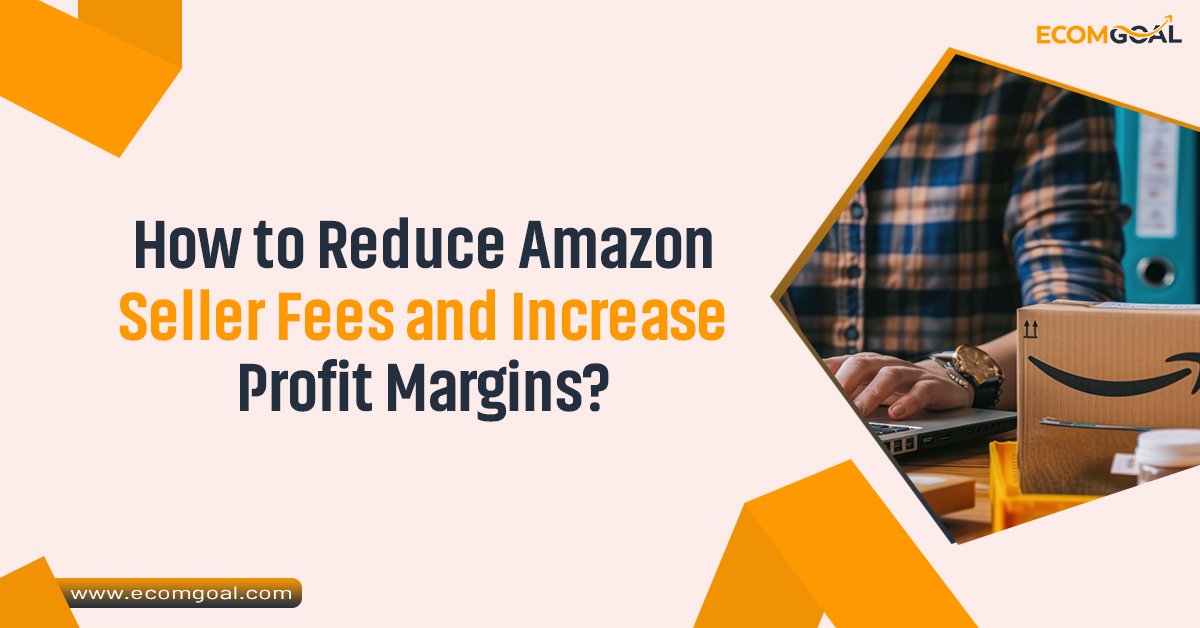
How to reduce Amazon seller fees and increase profit margins? Selling on Amazon presents a great opportunity for businesses to reach millions of customers worldwide. However, Amazon’s seller fees can sometimes eat into your profits, making it challenging to achieve the margins you desire. For sellers who want to maintain a competitive edge, learning how to minimize these fees and boost profit margins is essential.
In this comprehensive guide, we’ll cover how Amazon’s fees work, strategies for reducing these fees, and actionable tips to increase your profit margins.
Understanding Amazon Seller Fees
Before exploring ways to reduce Amazon fees, it’s important to understand the different types of fees you may encounter as a seller on the platform. Amazon imposes various fees depending on whether you use Fulfillment by Amazon (FBA) or Fulfillment by Merchant (FBM). Here’s a breakdown of some key fees:
- Referral Fees
Amazon charges sellers a percentage of each sale as a referral fee. This fee varies by category but typically ranges from 6% to 15%. For example, electronics usually incur a 8% fee, while beauty and personal care products may carry a 15% fee. - FBA Fulfillment Fees
If you’re using FBA, Amazon charges a fulfillment fee based on the size and weight of the product. These fees cover storage, picking, packing, & shipping. The larger and heavier your product, the higher the fulfillment fees. - Monthly Storage Fees
In addition to fulfillment fees, FBA sellers must pay monthly storage fees based on how much space their inventory occupies in Amazon’s warehouses. Storage fees increase significantly during the holiday season (October to December). - Closing Fees (Media Products)
For media products like books, DVDs, and music, Amazon charges a closing fee of £0.50 per sale (or local currency equivalent), in addition to referral and fulfillment fees. - Other Fees
Other costs, such as high-volume listing fees, return processing fees, and long-term storage fees, can also impact your profit margins.
Step-by-Step Guide How to Reduce Amazon Seller Fees and Increase Profit Margins?
1. Optimize Product Pricing
One of the simplest and most effective ways to reduce Amazon seller fees and increase profits is by optimizing your product pricing. By doing so, you can ensure that your margins remain healthy even after Amazon deducts fees.
Tips for Optimizing Pricing:
- Research Competitors: Regularly check how your competitors price similar products. Use Amazon’s Pricing Dashboard to monitor market trends and ensure that your product is competitively priced while covering fees.
- Factor in Fees from the Start: Calculate all fees (referral, FBA, and closing fees) before setting your product’s final price. Use Amazon’s Revenue Calculator to estimate these costs accurately.
- Set Strategic Price Points: Many categories have tiered fee structures based on price ranges. For instance, a product priced slightly higher might push you into a higher referral fee bracket. Adjust pricing carefully to avoid unnecessary fees.
2. Reduce FBA Fulfillment Fees by Optimizing Product Size and Weight
Amazon’s FBA fulfillment fees are directly tied to the size and weight of your products. Reducing your product’s weight or packaging size can have a dramatic impact on fulfillment fees.
Ways to Reduce FBA Fulfillment Fees:
- Use Compact Packaging: If possible, use packaging that minimizes the product’s dimensions. Amazon has a size-based pricing system, so a smaller package can result in significantly lower fees. Ensure that your product falls within the “small standard-size” category to minimize fulfillment costs.
- Choose Lighter Products: Heavier items incur higher fulfillment fees, so try to focus on selling lightweight products when possible. If your product has multiple size options, consider offering the lighter version to reduce costs.
- Utilize Frustration-Free Packaging: Amazon offers a Frustration-Free Packaging (FFP) program that eliminates excessive packaging and reduces costs. Enrolling in this program can lower fulfillment fees and improve customer experience.
3. Minimize Storage Fees
Amazon’s FBA storage fees are charged monthly based on the volume of inventory stored in their warehouses. Products that sit in storage for too long, especially during peak seasons, can incur hefty long-term storage fees, further reducing your profits.
Tips for Minimizing Storage Fees:
- Forecast Inventory Accurately: Use Amazon’s Inventory Dashboard and Restock Inventory Tool to forecast your sales accurately. Avoid overstocking items that will sit in storage for months, as this will increase storage fees.
- Create Removal Orders for Slow-Moving Inventory: If you have products that aren’t selling, request their removal from Amazon’s warehouses to avoid long-term storage fees. You can then sell these products through other channels, such as eBay or your own website.
- Use Inventory Performance Index (IPI) Insights: Amazon uses the Inventory Performance Index (IPI) to track how well you manage your FBA inventory. Maintaining a high IPI score by efficiently managing stock levels can help you avoid additional storage fees.
Learn More: How to Troubleshoot and Resolve Amazon Listing Errors?
4. Use Fulfillment by Merchant (FBM) for Certain Products
While Fulfillment by Amazon (FBA) offers many benefits, such as Prime eligibility and streamlined logistics, it isn’t always the most cost-effective option for every product. In some cases, fulfilling orders yourself through Fulfillment by Merchant (FBM) may help reduce fees and improve margins.
When to Use FBM:
- For Heavy or Bulky Products: Large or heavy products can result in high FBA fees due to the weight-based pricing model. In such cases, fulfilling orders yourself or using a third-party logistics provider (3PL) may be more economical.
- Low Sales Volume Products: If certain products have low sales volumes, storing them in Amazon’s warehouses can result in high storage costs. Using FBM ensures you only pay for fulfillment when a sale is made.
- Seasonal Products: Products with peak demand during specific times of the year may incur high storage fees when stored off-season. For such items, FBM may be a more affordable fulfillment option.
5. Take Advantage of Multi-Channel Fulfillment (MCF)
Amazon’s Multi-Channel Fulfillment (MCF) program allows you to use their fulfillment network to store and ship orders for sales made on other platforms, such as eBay, Shopify, or your own website. By consolidating fulfillment through Amazon’s warehouses, you can save on shipping costs and improve operational efficiency.
Benefits of Using MCF:
Lower Shipping Rates: Amazon’s vast logistics network allows you to access discounted shipping rates, even for non-Amazon orders. This can reduce overall fulfillment costs.
Simplified Inventory Management: By centralizing your inventory with Amazon’s MCF, you don’t need to manage separate inventories for different sales channels, which can save time and resources.
6. Take Advantage of Amazon’s Fee Promotions
Amazon occasionally runs promotions that reduce certain seller fees, particularly for new sellers or those using specific programs. Staying informed about these promotions can help you reduce your fees and increase profit margins.
Common Fee Promotions:
- New Seller Incentives: If you’re new to Amazon, take advantage of promotional fee reductions or waived FBA fees for the first few months.
- Lightning Deals or Prime Day Promotions: Amazon may offer reduced fees for sellers participating in Lightning Deals or Prime Day promotions. While participation often requires an upfront cost, the increased sales volume and reduced fees can result in higher profits.
7. Leverage Amazon’s Advertising Options Wisely
Advertising on Amazon through Sponsored Products, Sponsored Brands, and Sponsored Display Ads can drive significant traffic to your listings, but it can also add to your overall costs. To maximize your profits, you’ll need to optimize your advertising strategy to reduce unnecessary spending.
Tips for Reducing Advertising Costs:
- Use Negative Keywords: Amazon allows you to add negative keywords to your ad campaigns to prevent your ads from appearing for irrelevant searches. This helps reduce wasted ad spend.
- Optimize Your Campaigns Regularly: Monitor your advertising campaigns frequently and adjust bids based on performance. Use Amazon’s Advertising Cost of Sale (ACoS) metric to gauge the profitability of your ads and make data-driven decisions.
- Test and Adjust: Regularly test different ad types, bidding strategies, and target keywords. Eliminating underperforming ads and focusing on high-conversion campaigns will improve your ROI.
8. Choose the Right Product Categories
Referral fees vary across categories, with some categories having lower fees than others. If possible, consider selling products in categories with lower referral fees to reduce your overall costs.
Categories with Lower Referral Fees:
- Electronics: Referral fees for electronics are typically lower (around 8%) compared to other categories like beauty or fashion (which can be as high as 15%).
- Amazon Brand Products: Amazon has introduced several product categories that offer reduced referral fees for sellers offering Amazon Private Label or Amazon Exclusives products. These categories often come with discounted fees and higher visibility.
Conclusion
Reducing Amazon seller fees and increasing profit margins requires a combination of strategic planning, ongoing monitoring, and efficient business practices. By optimizing product pricing, reducing fulfillment and storage costs, leveraging fee promotions, and making data-driven decisions, you can minimize your fees and ensure that your Amazon business remains profitable.
With the right approach, you can maintain competitive prices while still achieving healthy profit margins, helping you grow and scale your business on the Amazon platform.

Hello, I am an E-commerce Expert with extensive experience providing services to numerous e-commerce brands and individuals since 2017. My primary areas of expertise include the Amazon, Walmart, and Shopify marketplaces. Linkedin
